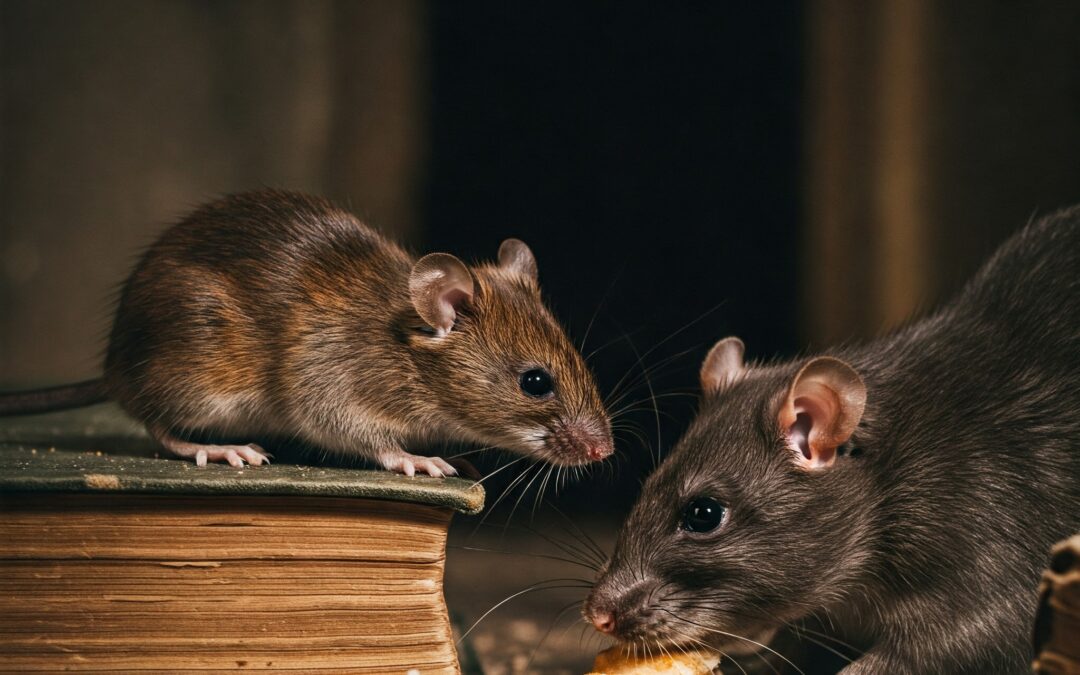About
Mice and rats are among the most widespread and adaptable rodents in the world, with extraordinarily diverse characteristics and habitats. These small mammals, belonging to the Muridae family, have colonized nearly every terrestrial environment, from tropical forests to arid deserts. Moreover, their exceptional adaptability has enabled them to establish themselves in human dwellings, making them well-known commensal species.
Mice and rats play a significant role in the food chain as prey for many predators, such as birds of prey, snakes, and carnivorous mammals. They also play an ecological role by dispersing seeds and aerating the soil through their digging activities. However, some species can also transmit diseases or damage crops.
Interesting Facts About Mice and Rats
- Mice and rats have continuously growing incisors and need to gnaw constantly to keep them at the proper length.
- A mouse can give birth to up to 10 litters per year, with 5–6 pups per litter.
- Rats are excellent swimmers and can survive in water for several days.
- Their sense of smell is highly developed, compensating for their relatively poor eyesight.
- Some rat species can reach up to 50 cm (including the tail).
Physical Characteristics
The physical features of mice and rats include streamlined, agile bodies adapted to their lifestyle. Though often confused, they have distinct differences. Mice are generally smaller (5–10 cm body length), with proportionally longer tails, larger ears, and pointier snouts. In contrast, rats are more robust (15–30 cm body length), with shorter tails, smaller ears, and more rounded snouts.
These rodents possess remarkable physical adaptations, such as highly sensitive vibrissae (whiskers) that help them navigate in the dark, and front paws with claws ideal for digging and manipulating food. Additionally, their prehensile tails provide exceptional balance while moving.
Size Comparison Table
| Characteristic | Mice | Rats |
|---|---|---|
| Size | 5–10 cm (body) + 5–10 cm tail | 15–30 cm (body) + 15–25 cm tail |
| Weight | 10–30 g | 150–600 g |
| Lifespan | 1–3 years | 2–4 years |
| Number of legs | 4 | 4 |
| Skin type | Short, dense fur | Fur varies by species |
| Horns | No | No |
| Colors | Gray, brown, white, black | Brown, gray, black, white |
Habitat and Distribution
The habitat of mice and rats is remarkably diverse, reflecting their exceptional adaptability. These rodents are found on every continent except Antarctica and have followed human migration around the globe. In natural environments, they prefer areas with shelter and abundant food, such as forests, grasslands, rocky areas, and riverbanks.
Commensal species like the house mouse (*Mus musculus*) and black rat (*Rattus rattus*) or brown rat (*Rattus norvegicus*) are especially well-adapted to living near humans. As a result, they are commonly found in urban areas, farm buildings, warehouses, and homes. Their presence is often linked to food and shelter availability.
These rodents have developed specific adaptations to their environments. Some rat species are excellent swimmers and can inhabit wetlands, while others are skilled climbers and prefer arboreal settings. Mice, on the other hand, excel in tight spaces thanks to their small size and agility.
Geographic Distribution
- North and South America
- Europe
- Asia
- Africa
- Oceania
Reproduction and Behavior
Mice and rats exhibit varying social behaviors depending on the species. However, most live in hierarchical groups with a complex communication system based on ultrasounds, scent marking, and body language. They also establish and defend territories marked with odor secretions.
Their reproductive cycle is highly efficient, contributing to their demographic success. Females can reproduce as early as 6–8 weeks of age and remain fertile for most of their lives. Gestation is short (19–21 days for mice, 21–23 days for rats), and litters are large. Moreover, females can mate again shortly after giving birth.
The young are born blind and hairless, but develop quickly—opening their eyes around 12–14 days and weaning at 3–4 weeks. This prolific reproduction allows mouse and rat populations to recover rapidly even after catastrophic events.
Among their unique behaviors is “bruxism” (teeth grinding) in rats, a sign of contentment similar to a cat’s purring. Their ability to learn and memorize spatial environments is also impressive, allowing them to navigate complex spaces effectively.
FAQ About Mice and Rats
What is the main difference between a mouse and a rat?
The most obvious difference lies in their size, with rats being significantly larger and heavier. Mice usually have a more pointed snout, larger ears, and a proportionally longer tail. Their behavior also differs—mice are more curious and exploratory, while rats are more cautious of new things.
How can I prevent a mouse or rat infestation in my home?
To prevent infestations, eliminate food sources by storing food in airtight containers. Seal any entry points, even small ones (a mouse can enter through a hole the size of a pencil). Keep your home clean, especially the kitchen, and consider using natural repellents like peppermint oil if necessary.
Are mice and rats dangerous to human health?
Yes, they can pose health risks. Mice and rats can transmit diseases such as leptospirosis, salmonellosis, and hantavirus, either directly or through parasites like fleas. Their droppings and urine can also contaminate food and surfaces. Any infestation should be taken seriously to protect occupants’ health.
What is the life expectancy of mice and rats in captivity?
In captivity, with optimal conditions and no predators, their lifespan increases significantly. Domestic mice can live 2–3 years, while domestic rats typically live 2–4 years. Some well-cared-for rats can even reach up to 5 years, much longer than in the wild.

